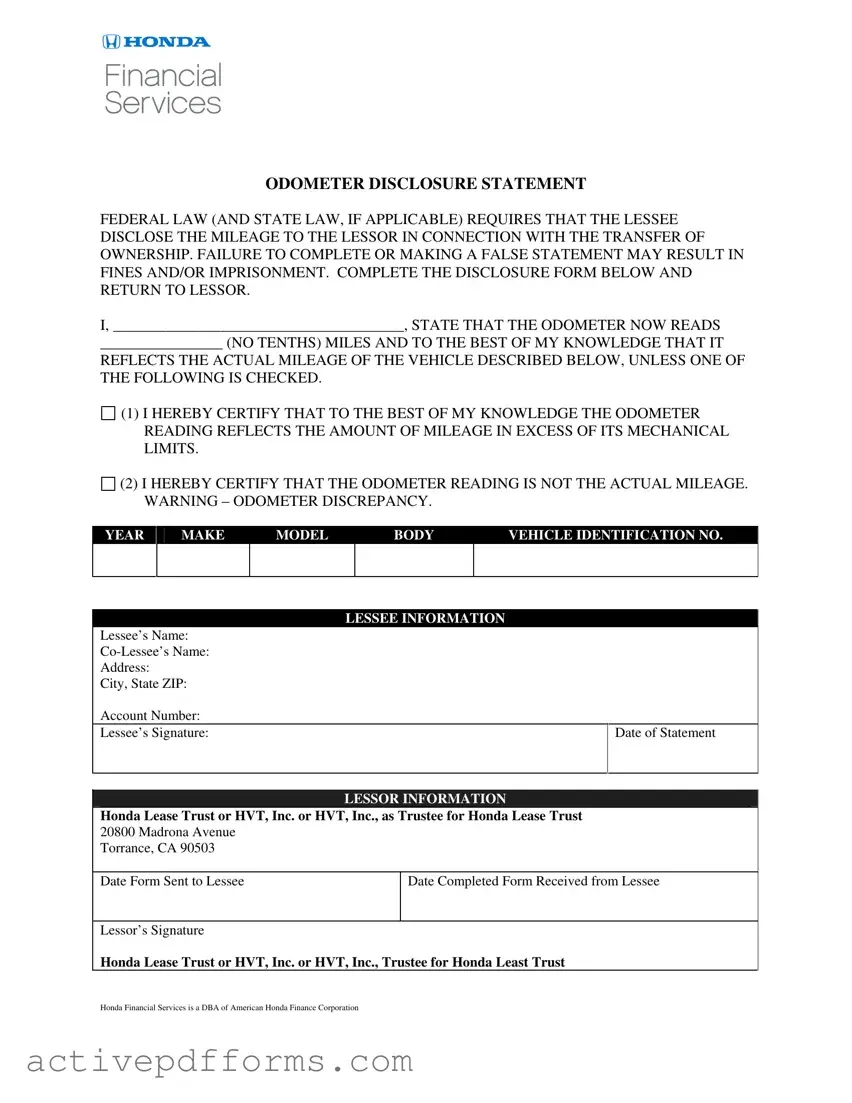ODOMETER DISCLOSURE STATEMENT
FEDERAL LAW (AND STATE LAW, IF APPLICABLE) REQUIRES THAT THE LESSEE DISCLOSE THE MILEAGE TO THE LESSOR IN CONNECTION WITH THE TRANSFER OF OWNERSHIP. FAILURE TO COMPLETE OR MAKING A FALSE STATEMENT MAY RESULT IN FINES AND/OR IMPRISONMENT. COMPLETE THE DISCLOSURE FORM BELOW AND RETURN TO LESSOR.
I, ______________________________________, STATE THAT THE ODOMETER NOW READS
________________ (NO TENTHS) MILES AND TO THE BEST OF MY KNOWLEDGE THAT IT
REFLECTS THE ACTUAL MILEAGE OF THE VEHICLE DESCRIBED BELOW, UNLESS ONE OF THE FOLLOWING IS CHECKED.
(1) I HEREBY CERTIFY THAT TO THE BEST OF MY KNOWLEDGE THE ODOMETER READING REFLECTS THE AMOUNT OF MILEAGE IN EXCESS OF ITS MECHANICAL LIMITS.
(2) I HEREBY CERTIFY THAT THE ODOMETER READING IS NOT THE ACTUAL MILEAGE. WARNING – ODOMETER DISCREPANCY.
|
|
YEAR |
|
|
MAKE |
|
|
MODEL |
|
|
BODY |
|
|
VEHICLE IDENTIFICATION NO. |
|
|
|
|
|
|
|
|
|
|
|
|
|
|
|
|
|
|
|
|
|
|
|
|
|
|
|
|
|
|
|
|
|
|
|
|
|
|
|
|
|
|
|
|
|
|
|
|
|
|
|
LESSEE INFORMATION |
|
|
|
|
|
Lessee’s Name: |
|
|
|
|
|
|
|
|
|
|
|
|
|
Co-Lessee’s Name: |
|
|
|
|
|
|
|
|
|
|
|
|
|
Address: |
|
|
|
|
|
|
|
|
|
|
|
|
|
|
|
|
City, State ZIP: |
|
|
|
|
|
|
|
|
|
|
|
|
|
Account Number: |
|
|
|
|
|
|
|
|
|
|
|
|
|
Lessee’s Signature: |
|
|
|
|
|
|
|
|
|
Date of Statement |
|
|
|
|
|
|
|
|
|
|
|
|
|
|
|
|
|
|
|
|
|
|
|
|
|
|
|
|
|
|
|
|
|
|
|
|
|
LESSOR INFORMATION |
|
|
|
|
|
HONDA LEASE TRUST OR HVT, INC. OR HVT, INC., AS TRUSTEE FOR HONDA LEASE TRUST |
|
|
20800 Madrona Avenue |
|
|
|
|
|
|
|
|
|
|
|
|
|
Torrance, CA 90503 |
|
|
|
|
|
|
|
|
|
|
|
|
|
|
|
|
|
|
|
|
|
|
Date Form Sent to Lessee |
|
|
|
|
|
Date Completed Form Received from Lessee |
|
|
|
|
|
|
|
|
|
|
|
|
|
|
|
|
|
|
Lessor’s Signature
HONDA LEASE TRUST OR HVT, INC. OR HVT, INC., TRUSTEE FOR HONDA LEAST TRUST
Honda Financial Services is a DBA of American Honda Finance Corporation

